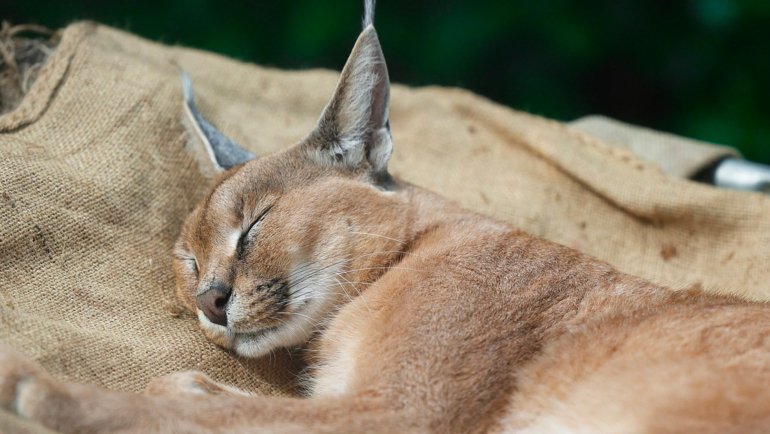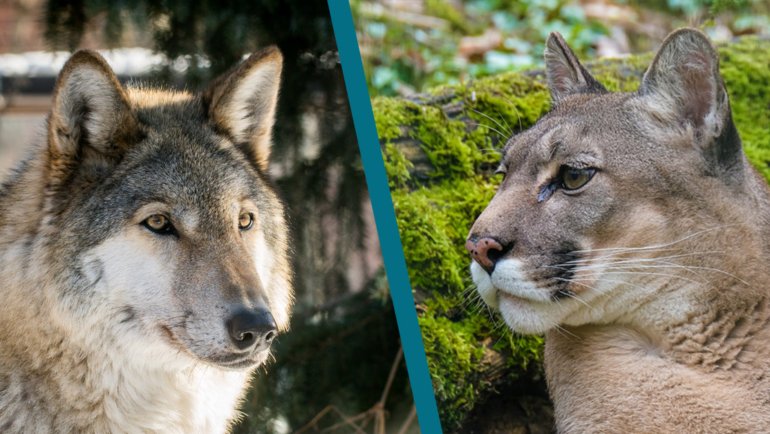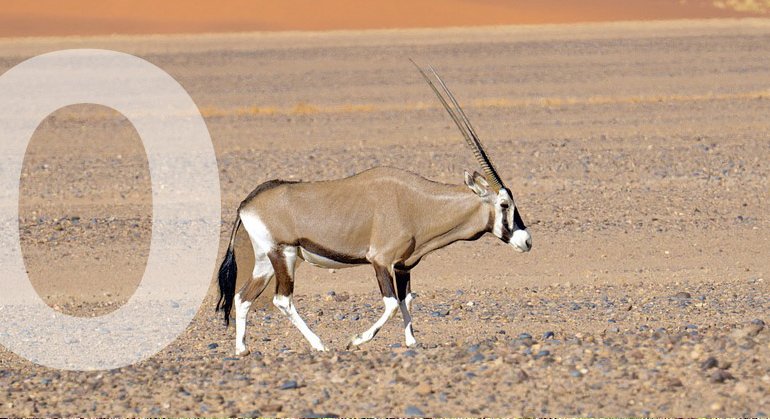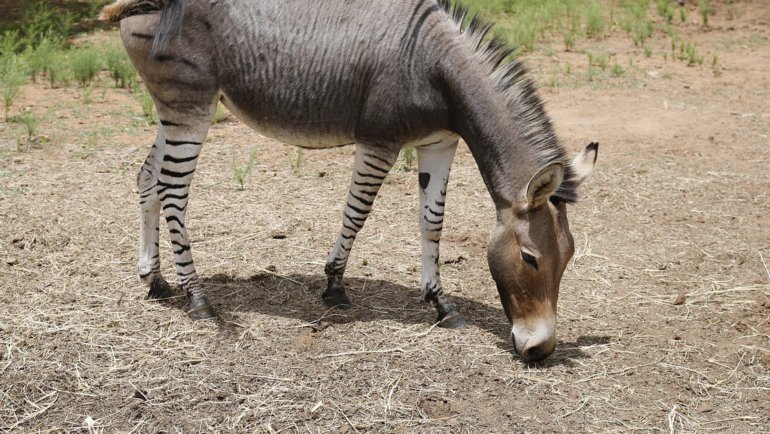The Bharal, also known as the blue sheep, is a fascinating herbivorous mammal found in the high-altitude regions of the Himalayas and parts of Central Asia. Despite its name, the Bharal is more closely related to goats than true sheep, and its thick, bluish-grey coat helps it blend into the rocky slopes where it thrives.
This elusive animal is renowned for its agility and ability to navigate steep terrain with ease. This fact sheet provides a comprehensive overview of the Bharal’s classification, physical characteristics, behavior, and conservation status, shedding light on one of the most iconic species of the Himalayas.
The Bharal at a Glance
Classification
| Kingdom: | Animalia |
| Phylum: | Chordata |
| Class: | Mammalia (Mammals) |
| Order: | Artiodactyla |
| Family: | Bovidae |
| Genus: | Pseudois |
| Species: | P. nayaur |
Essential Information
| Average Size: | 3.3-4.6 ft (100-140 cm) body length; 2.5-3 ft (75-90 cm) at shoulder height |
| Average Weight: | 77-165 lbs (35-75 kg) |
| Average Lifespan: | 10-15 years in the wild |
| Geographical Range: | Himalayas, Tibet, Nepal, Bhutan, India, Pakistan, China |
| Conservation Status: | Least Concern (IUCN Red List) |
Species and Subspecies
The Bharal, or blue sheep, belongs to the genus Pseudois and is classified as Pseudois nayaur. Within this species, there are two recognized subspecies: Pseudois nayaur nayaur, which inhabits the northern parts of the Himalayan range, and Pseudois nayaur schaeferi, also known as the dwarf blue sheep, which is smaller and confined to certain regions of Tibet and China.
While these subspecies share many similarities in behavior and habitat, P. n. schaeferi is differentiated by its smaller size and more restricted geographical range. The dwarf blue sheep also faces higher conservation pressures due to habitat loss and competition with livestock in its native regions.
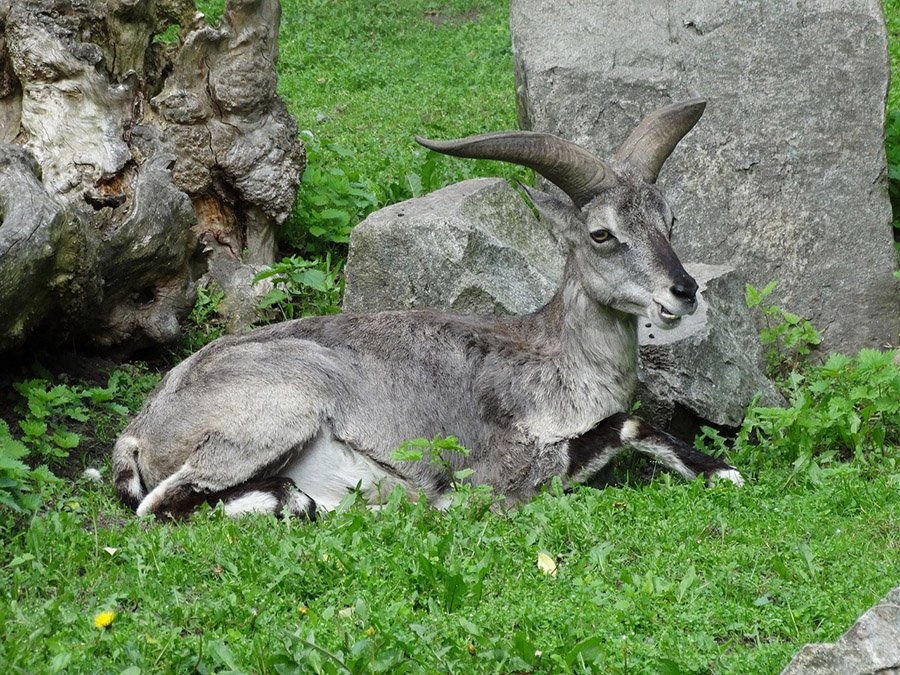
Description
The Bharal is a medium-sized ungulate with a sturdy, muscular body built for life in mountainous terrain. Its thick, bluish-grey coat, which gives it its common name of “blue sheep,” provides excellent camouflage among the rocky outcrops it inhabits. The animal’s underbelly is white, while its legs are tan or light brown.
Adult males are larger than females, with males growing up to 4.6 feet (140 cm) in body length and weighing up to 165 pounds (75 kg), while females tend to be smaller, averaging around 3.3 feet (100 cm) in length and weighing up to 110 pounds (50 kg).
One of the most distinctive features of the Bharal is its large, backward-curving horns, which are present in both males and females, though they are much larger in males. Male horns can grow up to 31 inches (80 cm) in length and curve backward in a sweeping arc, whereas female horns are shorter and more slender. These horns are used in displays of dominance and during mating contests between males.
Sexual dimorphism in Bharal is subtle, with males generally being larger and more robust than females. Both sexes have keen eyesight and nimble hooves, which allow them to traverse steep, rocky slopes with ease. This agility is crucial for avoiding predators and navigating their often precarious environment.
Habitat and Distribution
The Bharal is found across the high-altitude regions of the Himalayas, including parts of India, Nepal, Bhutan, and Tibet. Its range extends into western China and Pakistan, where it inhabits the steep, rocky cliffs and alpine meadows of elevations ranging from 9,800 to 18,000 feet (3,000 to 5,500 meters). These animals are perfectly adapted to life in harsh, cold environments with sparse vegetation, surviving on steep slopes that offer protection from predators.
Bharal prefer open, rocky habitats that provide both food and shelter. They are commonly found in areas with grassy slopes interspersed with rugged cliffs, where they can graze on alpine grasses and shrubs while remaining out of reach from most predators. Their ability to thrive in such inhospitable terrain makes them one of the most iconic species of the Himalayan region.
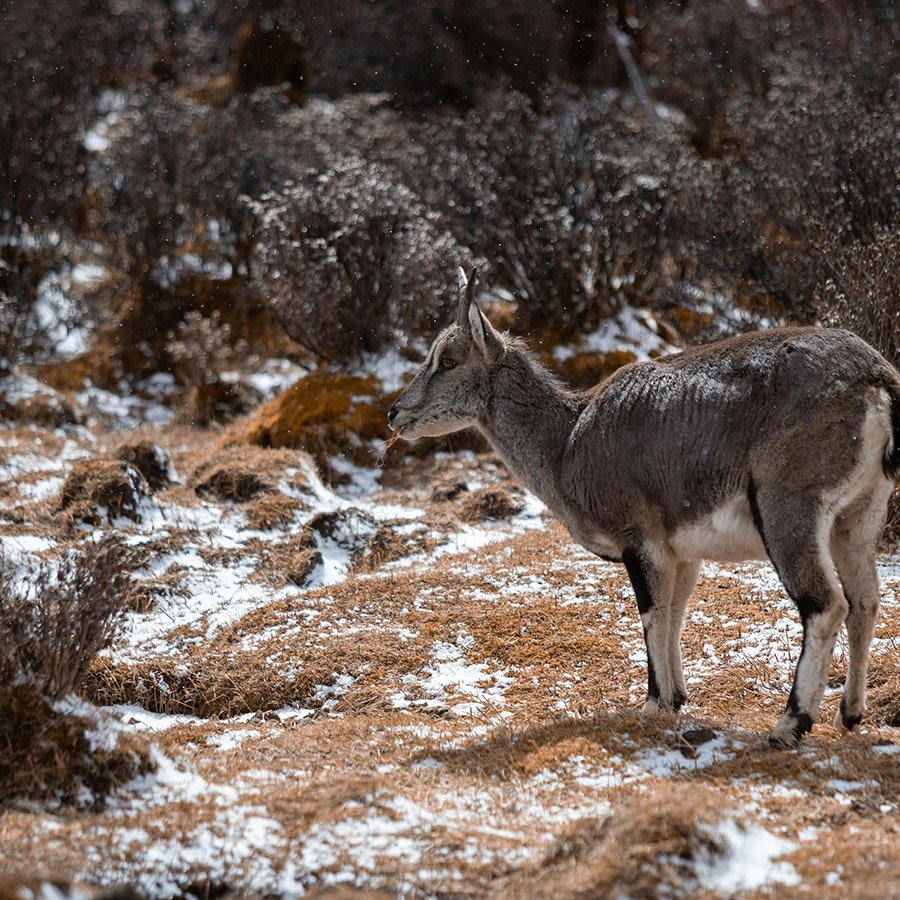
Behavior
Bharal are primarily diurnal, meaning they are most active during the day. They spend the majority of their time grazing on alpine grasses, shrubs, and herbs. These animals are social and typically live in herds, with group sizes varying depending on the availability of food and environmental conditions.
During the warmer months, herds can range from small groups of females and their young to larger mixed groups of up to 100 individuals. Male Bharal tend to be more solitary or form smaller bachelor groups outside of the breeding season.
Communication among Bharal is primarily visual, with dominance displays among males involving head-butting contests during the mating season. These displays are often accompanied by low-pitched grunts or calls, though vocal communication is generally limited. Instead, Bharal rely on body language and the positioning of their horns to communicate dominance, submission, or alarm.
Their remarkable climbing abilities allow them to evade predators by quickly retreating to higher ground when threatened. This agility, combined with their keen eyesight, helps them avoid predators such as snow leopards and wolves that share their rugged habitat.
Diet and Feeding Behavior
The Bharal is a herbivore, primarily feeding on the tough, dry grasses, shrubs, and herbs that grow in its mountainous environment. During the summer, when vegetation is more abundant, Bharal graze extensively, consuming grasses and sedges.
As winter approaches and food becomes scarcer, they shift to browsing on shrubs, mosses, and lichens. Despite the harsh conditions in which they live, Bharal are well-adapted to extract nutrients from these sparse food sources.
Their feeding behavior is characterized by selective grazing, and they are often seen scaling steep slopes to access patches of grass or herbs that are out of reach for other herbivores. Bharal are also known to forage in areas where domestic livestock graze, leading to competition for food in some regions. This competition can be particularly problematic in areas where livestock overgraze and reduce the availability of food for wild species.
Bharal have a unique digestive system that allows them to process the tough, fibrous vegetation found at high altitudes. Their multi-chambered stomachs enable them to break down cellulose and extract vital nutrients, helping them survive in environments where food is scarce.
Predators
The primary predator of the Bharal is the snow leopard, which is perfectly adapted to the same rugged, high-altitude environments. Snow leopards rely on stealth and surprise to catch Bharal, often ambushing them on steep slopes where escape is difficult.
In addition to snow leopards, wolves and Himalayan brown bears are also known to prey on Bharal, though encounters with these predators are less common.
Young Bharal are particularly vulnerable to predation, as they lack the speed and agility of adults. Juveniles may fall prey to birds of prey, such as golden eagles, which can snatch young animals from the cliffs. However, adult Bharal, with their keen senses and climbing skills, are often able to evade predators by retreating to steep, inaccessible terrain.
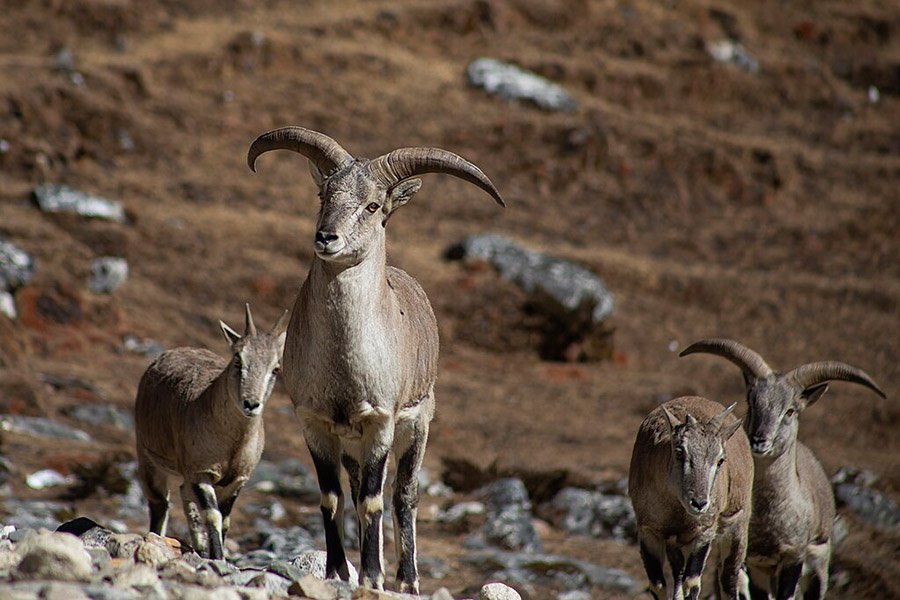
Reproduction and Life Cycle
Bharal breeding season typically occurs between November and January. During this time, males engage in fierce battles for the right to mate, clashing their horns in dramatic head-butting contests. The dominant males will mate with multiple females, while subordinate males are often excluded from the breeding process.
Following a gestation period of approximately 160 days, female Bharal give birth to a single offspring, though twins are occasionally reported. Births usually occur in late spring or early summer when the weather is milder and food is more plentiful. The young are born in secluded rocky areas, where they are protected from predators during their vulnerable early days.
Mother Bharal are highly protective of their young and nurse them for several months until they are able to graze on their own. The young remain with their mothers for about a year before becoming independent, at which point they join a larger herd or form bachelor groups in the case of males.
Conservation and Threats
Currently, the Bharal is classified as “Least Concern” by the IUCN due to its relatively stable population and wide distribution across the Himalayan region. However, certain local populations face threats from habitat loss, competition with livestock, and illegal hunting.
Overgrazing by domestic livestock has reduced the availability of food in some regions, leading to increased competition between Bharal and livestock for grazing areas.
Conservation efforts for the Bharal include the establishment of protected areas and wildlife reserves in countries like Nepal, Bhutan, and China. These protected areas aim to preserve the natural habitats of the Bharal and other high-altitude species, such as the snow leopard. In addition, some organizations work to promote sustainable grazing practices and reduce human-wildlife conflict by providing alternative livelihood options for herders.
Ongoing conservation programs are vital to ensuring the long-term survival of the Bharal, especially in areas where human activities are increasingly encroaching on its habitat. Continued monitoring of Bharal populations and habitat conditions is necessary to prevent further declines.
Fun Facts
- Despite being called a “blue sheep,” the Bharal is actually more closely related to goats than true sheep, and its agility on rocky slopes is more goat-like.
- The blueish tint of the Bharal’s coat provides excellent camouflage against the rocky Himalayan cliffs, making it difficult for predators to spot them from a distance.
- Bharal are expert climbers and can scale almost vertical cliffs to escape predators, often disappearing into the high-altitude rock faces where few animals can follow.
- During the rutting season, male Bharal engage in intense horn clashes, with the sound of their battles echoing through the mountains as they vie for dominance and mates.
- Bharal play a critical role in the high-altitude ecosystem, serving as a primary prey species for the endangered snow leopard, making their conservation vital for the survival of this big cat.
Frequently Asked Questions
What is a Bharal?
The Bharal, or blue sheep (Pseudois nayaur), is a herbivorous mammal found in the high-altitude regions of the Himalayas and parts of Central Asia. It is closely related to goats rather than sheep.
Where do Bharal live?
Bharal are native to the mountainous regions of the Himalayas and Tibet, and they inhabit steep, rocky cliffs at elevations ranging from 9,800 to 18,000 feet (3,000 to 5,500 meters).
What do Bharal eat?
Bharal are herbivores and primarily feed on alpine grasses, shrubs, and herbs. In winter, when food is scarce, they survive by browsing on lichens, mosses, and other tough vegetation.
Who are the Bharal’s main predators?
The snow leopard is the primary predator of the Bharal. Other predators include wolves and Himalayan brown bears, though encounters with these animals are less common.
Are Bharal endangered?
No, the Bharal is currently listed as “Least Concern” by the IUCN. However, certain local populations face threats from habitat loss, competition with livestock, and hunting.
